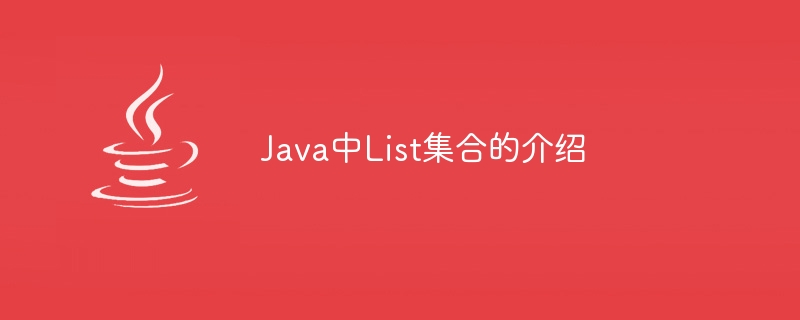Summary of List collection in Java

Introduction to List collection in Java
In Java programming, List is one of the commonly used collection classes. It provides an ordered collection that can store a sequence of elements and allows elements to be repeated. The List interface inherits from the Collection interface and provides some other methods to operate elements in the collection. The following will introduce in detail the characteristics, common methods and code examples of List collections.
- Characteristics of List collection
- List collection is ordered, and each element is accessed through an index. This index starts from 0 and increases sequentially. An element can be added, removed, or accessed based on its index.
- List collection allows duplicate elements. The same element can be added to the collection multiple times.
- List collection can be dynamically resized. Elements in the collection can be added or subtracted at any time as needed.
- Common methods
- add(Object element): Add an element to the List collection.
- remove(int index): Remove an element from the List collection based on the index.
- get(int index): Get an element from the List collection according to the index.
- size(): Returns the number of elements in the List collection.
- contains(Object element): Determine whether the List collection contains the specified element.
- indexOf(Object element): Returns the index of the specified element in the List collection.
- addAll(Collection c): Add all elements in a Collection to the List collection.
- clear(): Clear all elements in the List collection.
The following are some code examples of List collections:
import java.util.ArrayList;
import java.util.List;
public class ListExample {
public static void main(String[] args) {
// 创建一个List集合
List<String> list = new ArrayList<>();
// 向List集合中添加元素
list.add("apple");
list.add("banana");
list.add("orange");
// 根据索引获取元素
System.out.println("第二个元素是: " + list.get(1));
// 获取List集合的大小
System.out.println("List集合的大小是: " + list.size());
// 判断List集合是否包含某个元素
System.out.println("List集合是否包含apple: " + list.contains("apple"));
// 删除List集合中的元素
list.remove(0);
System.out.println("删除第一个元素后的List集合: " + list);
// 清空List集合
list.clear();
System.out.println("清空List集合后的大小: " + list.size());
}
}The output result is:
第二个元素是: banana List集合的大小是: 3 List集合是否包含apple: true 删除第一个元素后的List集合: [banana, orange] 清空List集合后的大小: 0
Through the above code examples, you can see the basic usage of List collections, Including operations such as adding, deleting, obtaining elements, and determining the size of the List collection.
Summary: List collection is one of the commonly used collection classes in Java. It provides an ordered collection that allows duplication of elements. By using the List collection, you can operate on a series of elements more conveniently. In actual development, we often use List collections to store and manage data. I hope that through the introduction of this article, readers will have a deeper understanding of the List collection.
The above is the detailed content of Summary of List collection in Java. For more information, please follow other related articles on the PHP Chinese website!

Hot AI Tools

Undresser.AI Undress
AI-powered app for creating realistic nude photos

AI Clothes Remover
Online AI tool for removing clothes from photos.

Undress AI Tool
Undress images for free

Clothoff.io
AI clothes remover

AI Hentai Generator
Generate AI Hentai for free.

Hot Article

Hot Tools

Notepad++7.3.1
Easy-to-use and free code editor

SublimeText3 Chinese version
Chinese version, very easy to use

Zend Studio 13.0.1
Powerful PHP integrated development environment

Dreamweaver CS6
Visual web development tools

SublimeText3 Mac version
God-level code editing software (SublimeText3)

Hot Topics
 Square Root in Java
Aug 30, 2024 pm 04:26 PM
Square Root in Java
Aug 30, 2024 pm 04:26 PM
Guide to Square Root in Java. Here we discuss how Square Root works in Java with example and its code implementation respectively.
 Perfect Number in Java
Aug 30, 2024 pm 04:28 PM
Perfect Number in Java
Aug 30, 2024 pm 04:28 PM
Guide to Perfect Number in Java. Here we discuss the Definition, How to check Perfect number in Java?, examples with code implementation.
 Random Number Generator in Java
Aug 30, 2024 pm 04:27 PM
Random Number Generator in Java
Aug 30, 2024 pm 04:27 PM
Guide to Random Number Generator in Java. Here we discuss Functions in Java with examples and two different Generators with ther examples.
 Armstrong Number in Java
Aug 30, 2024 pm 04:26 PM
Armstrong Number in Java
Aug 30, 2024 pm 04:26 PM
Guide to the Armstrong Number in Java. Here we discuss an introduction to Armstrong's number in java along with some of the code.
 Weka in Java
Aug 30, 2024 pm 04:28 PM
Weka in Java
Aug 30, 2024 pm 04:28 PM
Guide to Weka in Java. Here we discuss the Introduction, how to use weka java, the type of platform, and advantages with examples.
 Smith Number in Java
Aug 30, 2024 pm 04:28 PM
Smith Number in Java
Aug 30, 2024 pm 04:28 PM
Guide to Smith Number in Java. Here we discuss the Definition, How to check smith number in Java? example with code implementation.
 Java Spring Interview Questions
Aug 30, 2024 pm 04:29 PM
Java Spring Interview Questions
Aug 30, 2024 pm 04:29 PM
In this article, we have kept the most asked Java Spring Interview Questions with their detailed answers. So that you can crack the interview.
 Break or return from Java 8 stream forEach?
Feb 07, 2025 pm 12:09 PM
Break or return from Java 8 stream forEach?
Feb 07, 2025 pm 12:09 PM
Java 8 introduces the Stream API, providing a powerful and expressive way to process data collections. However, a common question when using Stream is: How to break or return from a forEach operation? Traditional loops allow for early interruption or return, but Stream's forEach method does not directly support this method. This article will explain the reasons and explore alternative methods for implementing premature termination in Stream processing systems. Further reading: Java Stream API improvements Understand Stream forEach The forEach method is a terminal operation that performs one operation on each element in the Stream. Its design intention is






